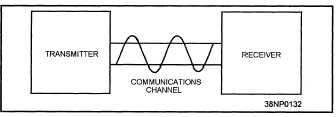CHAPTER 1
FUNDAMENTALS OF DATA COMMUNICATIONS
INTRODUCTION
Although you, as a Fire Controlman, may not be directly involved in data
communications, you definitely need to be aware of how data communications
affects your ship’s mission.
This training manual introduces and explains the
basics of data communications. Computer data frequently must be transmitted from
one point to another. The distance involved maybe a few feet, or it may be hundreds
of miles. Data transited over long distances often must be converted to a form
compatible with either landline or radio wave transmission and reception. This
chapter explains how such conversion occurs and techniques used in the conversion
and transmission procedures.
After completing this chapter, you should be able to:
State the types of communications systems.
Describe the decibel system of power measurement.
Explain asynchronous and synchronous communications as used in data
communications systems.
Describe the methods of data modulation and demodulation used in
various types of data networks.
Describe the operation of modems used in data communications
networks.
Describe the methods of multiplexing data in communications networks.
COMMUNICATIONS SYSTEMS
The devices used to transfer digital data makeup
what is known as a communications system. In its
most basic form, a communications system consists of
the three components shown in figure 1-1. They are
Figure 1-1.—Communications system.
the transmitter, the receiver, and a communications
channel that connects the two units.
The transmitting equipment converts the data of
the sending system into a form that can be sent over
the communications channel, accepted by the
receiving equipment, and converted back into usable
data by the receiving system.
Data sent over a
communications system is in one of the following two
forms: analog or digital.
An analog signal used in data communications
varies continuously between a minimum and a
maximum value. As the signal varies, it assumes an
infinite number of specific values between the two
1-1


